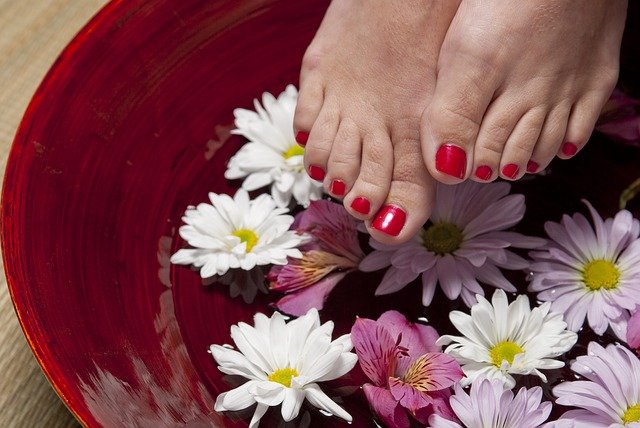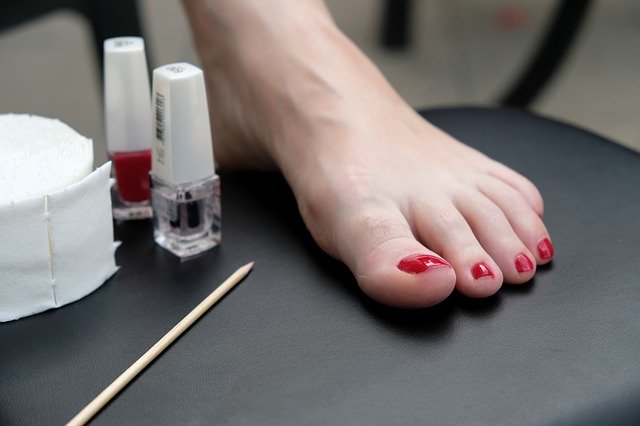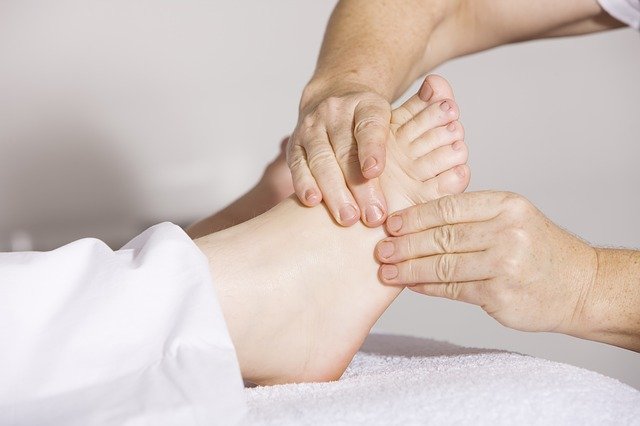Your feet are one of the most overworked and under-appreciated parts of your body. They are subjected to years and years of walking and running, improper footwear and usually a great deal of neglect. How about looking after them with a pedicure at home this weekend?

While it may be a challenge to replicate the treatment that a trained professional can offer, a DIY pedicure can be just as effective for your feet. If you’ve never done it before or are worried about damaging your nails, this article will help you complete a simple and effective DIY pedicure at home.
What is a DIY pedicure?
A DIY (Do-It-Yourself) pedicure is an easy indulgence that both men and women can enjoy. If you can’t get to the nail salon, doing it at home is an easy, convenient solution that you might prefer.
A DIY pedicure is suitable for everyone but is great if you have a regular workout routine, have a job that requires you to stand all day or you wear heavy regulation shoes at work. But it is also a wonderful self-care routine for anyone who is looking for a little me-time this weekend.

A DIY pedicure is easier when you have the right tools, but there are several hacks that require items that can be easily found in any Aussie home.
What do I need for a pedicure at home?
Before you get started on your DIY pedicure, make sure you have the right equipment close at hand. The last thing you want is to be hobbling about with oily or soapy feet, looking for that nail file.
You need to do four basic tasks for your pedicure at home. These are:
Foot and nail care: Before you begin, remove any old nail polish and foot jewellery. Many people clip their nails after soaking, but it is easier to clip them when they are dry and your fingers are not slippery.
Soak your feet: This cleans and softens the skin and preps it for the treatment you are about to do.
Scrub: You’ll need to scrub your feet to clean them and get rid of any dead or rough skin. A pumice stone is the most effective solution, but a loofah is good enough. If you don’t have either, mix equal quantities of organic cold-pressed cooking oils (coconut, olive, or avocado) and sugar for your very own DIY scrub.
Foot cream: This is the fun part. Slather on a thick emollient like foot cream or a rich oil, massage into your feet and put on a thick pair of socks.
For these tasks, you will need the following equipment:
- Nail scissors or nail clippers
- Nail file (optional)
- Nail polish remover and cotton wool pads (if you have nail polish on)
- Tub or basin for soaking your feet
- Liquid soap or body wash
- Pumice stone or loofah
- Foot cream
- Thick socks
- Hand towel
- Cuticle cream and cuticle pusher (optional)
- Nail buffer
How do I do a pedicure at home?
A DIY pedicure at home is so easy that you may decide to turn it into a regular ritual. Here’s how to do it.
Step 1
Remove all chipped nail polish, anklets, and toe rings if you have any of these. If your nails are
Step 2
Clip your toenails short and stick to a basic square shape, cutting in a straight line across the nail. Don’t cut too close to your skin or too deep into the corners. Do not try and shape your nails into ovals as this puts you at risk of ingrown nails. For a DIY pedicure, keep it simple. File your nails if there are rough edges.
Step 3
Fill a tub with hot water and squeeze in a moisturizing body wash or liquid soap. Bonus points if you add bath salts! You might also like to throw in a few used tea bags (green tea, mint or chamomile are great) or slices of lemon for a refreshing foot soak. Soak your feet in the hot water for 10-15 minutes.
Step 4
Using a loofah, scrub your feet well. Use a pumice stone on tougher areas like heels or the balls of your feet. Scrub gently and do not press on bony areas or tender skin.
Step 5
Dip your feet back into the water and let them soak for a few minutes longer.
Step 6
This is an optional step. Take your feet out of the water, pat dry, and apply cuticle cream at the base of each nail. Allow the cream to soak in for a few minutes and then wipe off with a cotton pad. Gently push the cuticles back with a cuticle pusher. Soak your feet again for a few minutes.
Step 7
Work on one foot at a time. Pat it dry with a towel and apply a generous amount of foot cream. Rub into your feet, adding more on dry areas like your heels if needed. Don’t forget to work the cream into your toes and between your toes. This is a great time to give your feet a massage to improve circulation and relax your muscles.
If you’re confident and you have the equipment, you might like to combine a foot massage with an indulgent at-home massage too.
Can I paint my nails when I’m done with a DIY pedicure?

Yes of course. Once you’ve finished your DIY pedicure, clean the foot cream off your toenails with nail polish remover. Use your nail polish of choice on dry feet with the following technique:
Roll your nail polish bottle between your palms to warm it. Do not shake the bottle. Dip the brush in the polish, wipe the excess off, and place the brush at the base of the nail.
Using three firm strokes – middle, left side, right side – apply the nail polish. Avoid using short strokes. Instead, drag the brush from the base of the nail to the very edge for a smooth look.
You might like to use a toe separator to keep your toes from smudging each other. A ball of cotton wool pushed between each toe works just as well.
What are the advantages of a pedicure at home?
A DIY pedicure offers all the benefits that you would get with a spa treatment, which are:
- It helps to prevent feet from drying out which can lead to calluses and torn skin
- It gives you a chance to examine your nails and feet for any health issues
- It improves skin elasticity making it less prone to tearing and reducing cracks
- It relaxes your feet and reduces foot pain

Before you begin
If you have foot problems or certain health conditions, a pedicure at home may not be suitable for you. For example, if you have diabetes or arthritis, there are specific foot care tips that you need to ensure. You should get a trained professional for any foot care.
If you have cuts, blisters or open wounds, wait for them to heal completely before trying a pedicure at home.
If you have bunions, calluses or any foot problems, a pedicure at home may aggravate the condition. In this case, you’re probably already wondering Where can I find a podiatrist near me for appropriate treatment.
If you are heavily pregnant or obese or if you have spine problems, a pedicure at home may not be suitable for you. Ask someone else to help you or get professional help.
Follow these tips for a safe pedicure at home
To ensure that your pedicure at home proceeds smoothly without any hiccups, you should take the following precautions:
- Do not dig under your nails with any tools. If you want to clean under your nails, use a nail brush with fresh water. Pushing at the skin under your nails can introduce bacteria and cause fungal infections.
- If you’re using a pumice stone, don’t scrub too hard or you may tear the skin. Use light strokes and gentle pressure and stick to the roughest areas like heels. A loofah is a safe bet, but nothing removes dead or rough skin like a pumice stone or a foot file.
- For long-lasting softness, slather foot cream on and wrap in cling wrap before putting socks on. Don’t wrap so tight that it is uncomfortable, and don’t walk with your feet wrapped or you might slip. Keep your feet up for 15-25 minutes and then unwrap.

A green-friendly pedicure at home
If you are concerned about the chemical components of the ingredients that go into a pedicure at home, here are some alternatives:
- For an effective and invigorating foot scrub, use ground coffee or sugar with coconut or olive oil and use the grainy mix to scrub your feet.
- Instead of foot creams, use natural oils or organic balms. For a DIY pedicure, the best oils are avocado or coconut oil because of their high fatty acid content. Make sure that the oils have been procured organically and are cold-pressed.
I’m not sure about doing a pedicure at home. What are my other options?
You don’t have to do a pedicure at home if you’re unsure. If you would prefer to not visit a salon, you could still choose from several mobile beauty and wellness solutions. These options offer several spa treatments with the comforts of your home.

Mobile salons employ trained and qualified mobile beauticians who are adept at working remotely. This is a great option for someone who has an irregular or busy schedule because you can book it at your convenience. They have all the equipment they need so you do not need to arrange anything.



